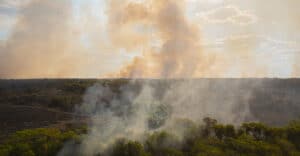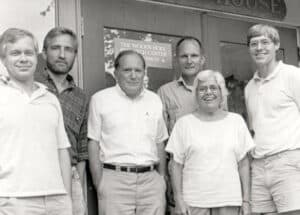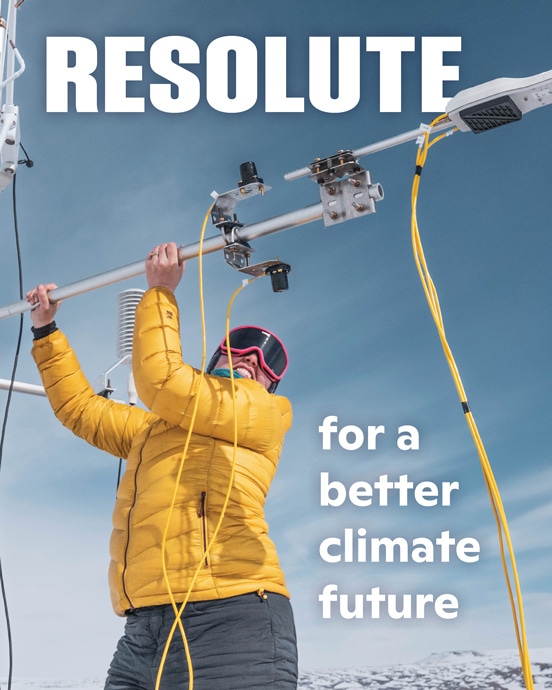New water quality technology makes its debut in Buzzards Bay

Baywatcher sampling titrating dissolved oxygen
Every five days, Lisa Kingston, a 62-year-old critical care nurse, drives to the Onset pier to collect samples in the murky waters of Buzzards Bay.
“This is our oxygen bottle and this is our salinity bottle. We pull this — bloop, bloop, bloop, bloop, bloop —” she says, imitating the sound of water, “and that fills up.”
At the end of this dock, Kingston performs an hour-and-a-half-long data collection routine — just as she has done 22 times a summer for the past two years. She and fellow volunteer Susan Scott are here to take measurements on oxygen, water temperature, salinity, and more. Scott, a 77-year-old retired arts administrator, rips open a reagent packet and adds it to a glass vial.
2024 Switzer Fellowships awarded to environmental change-makers
Twenty environmental leaders have been chosen as 2024 recipients of the Switzer Environmental Fellowship, a program of the Robert and Patricia Switzer Foundation that awards graduate students a $17,000 cash award and leadership training to support their education and career development at 12 universities in New England and California. The 20 fellowships total $340,000 in awards.
During their fellowship year, Switzer Fellows cultivate their personal leadership skills toward advancing social equity, build relationships, and expand their networks through shared learning and professional development activities. Switzer Fellows receive support throughout their careers to pursue interdisciplinary and collaborative work, positioning them for leadership in the nonprofit, government, philanthropic, private, and academic sectors. The competitive fellowships are awarded based on leadership potential and commitment to environmental problem-solving. Switzer Fellows demonstrate innovation and collaboration, as well as commitment to advance social equity as a fundamental part of their environmental work. The 2024 Switzer Fellows join a network of over 750 Switzer Fellows working across the United States and around the world.
“The Switzer Foundation believes that talented and committed individuals can make change in the world, and we invest in supporting their continued leadership and professional development,” says Executive Director, Sarah Reed. “As lifelong members of the Switzer Network, the new fellows will be able to increase their impact as environmental leaders through shared learning, collaboration, and mutual support. We are thrilled to welcome these environmental and social change-makers to our community as 2024 Switzer Fellows.”
Robert and Patricia Switzer established the foundation with a belief in the power of individuals to make positive change in the world, and to support and encourage people dedicated to solving applied environmental problems. The 2024 Switzer Fellows come from diverse social, academic, and economic backgrounds and bring an impressive breadth of expertise on topics including agriculture, agroecology, avian ecology, environmental justice, environmental policy, environmental remediation, food systems & access, forestry, holistic land management, housing decarbonization, public health, renewable energy, tribal sovereignty, and urban planning. More information about the 2024 Switzer Fellows, and links to their profiles, is available on the Founation website.
The Robert and Patricia Switzer Foundation identifies and nurtures environmental leaders to create positive environmental change. The foundation awards academic fellowships and project grants, sponsors professional development activities, and fosters a vibrant network of more than 700 Switzer Fellows who are environmental and social change leaders working across academia, non-profits, government, philanthropy, and the private sector. For more information, see their website.
I am a woman that lives for adventure, mud, and heat. The Caribbean sunshine, warmth, and humidity of my island, Boriké, hug me every single day. That’s why many people find it strange that in the summer of 2022 I ended up on the other side of the world from my Carribean Island home, willingly experiencing freezing temperatures.
So, here’s my story: I grew up in Puerto Rico, a couple of Caribbean islands that are very vulnerable to the effects of climate change. The burning of fossil fuels and the destruction of forests are causing Arctic ice to melt which, in addition to affecting the climate of the planet, is affecting Boriké. Rising sea levels, more frequent and stronger hurricanes, and constant landslides are some of the dangers I am already experiencing on my island.
Although I do a lot of environmental work there, a few years ago I decided to visit the Arctic to fully understand how climate change is also affecting other types of ecosystems. Because climate change is a global phenomenon, I sought to learn how to properly support and collaborate with other at-risk communities outside of the boundaries of my islands, even if that meant stepping outside my comfort zone in another part of the world.
The problem was: I’ve never lived in polar temperatures. I’ve hiked hundreds of miles of coastal and humid tropical forests to conduct research, yet visualizing myself as an Arctic scientist in an environment so different was nearly impossible.
But as I said before, I am a woman that lives for adventure, so if I was going to experience a new environment I was going to get the full experience.
So that summer I packed up my giant backpack and joined eight other young researchers for Woodwell Climate’s Polaris Project— a two-week long research trip in the Yukon Kuskokwim Delta of Alaska. Polaris gives students the chance to design their own studies and gain experience conducting Arctic research. It was with Polaris that my battle against the cold began.
I spent my time in remote areas of the Tundra, a carbon-rich ecosystem lacking mountains and trees, yet full of life and history. I had to live in a tent to conduct my research on how the groundwater system is changing. My usual day in the Arctic looked like lots of hiking in the mud, carrying pipes and drills in my backpack, wearing mosquito nets, and taking water and soil samples in temperatures as low as 48 degrees Fahrenheit. Although 48 degrees might not be cold for many folks on Turtle Island— the original name for North America — as someone from the Caribbean, anything below 70 degrees is already too cold to handle.
Add onto that, the rainy days, the lack of access to communications, internet, electricity, and water service. Needless to say, my first experience with cold was an intense one.
But you know what? I loved it.
I loved working with new friends, colleagues, and mentors. I loved getting to know the Yup’ik and Cup’ik communities guarding these lands. I loved doing science projects that served a common good.
I loved fieldwork in the cold.
However, when I went back home and felt that rich Caribbean sunshine and heat again, I began questioning myself.
How could I have enjoyed working in the cold? Could I really be a scientist in the Arctic even though I didn’t grow up in the Arctic? My Polaris experience lasted only two weeks, and they were the most challenging two weeks of my entire career. Could I endure weeks, months, or even years in these conditions?
Would I let the cold win this battle?
Well, I would have to face the cold one more time either way. Polaris students present the results of their research each year at the American Geophysical Union conference in December. To give my research presentation, I had to travel to Chicago— in the middle of winter.
Have you ever felt the chilling winds of Chicago? It’s known as the windy city for crying out loud! I guess it was time for me to get back to the battlefield.
I packed all my coats, got on a plane, touched down in traditional Potawatomi lands, and tried not to freeze to death.
The wind and snow was strong the day I had to present my research. It was actually my first time experiencing snow falling from the sky, so I bundled up warmly. But as I was walking to the convention center, going over in my mind the speech I had to give, I felt the most chilling cold I had ever experienced in my life. When I looked down at my feet, I realized that I had packed the wrong shoes! In thin flats, my feet were totally exposed.
This was the moment you might conclude that the cold finally beat me. Yet, when I looked back down at my exposed feet, I just couldn’t stop laughing.
After so much effort to “win the battle”, at that very moment I realized the battle doesn’t exist. There is no battle against the cold.
Living in the cold is a lifestyle like any other. Just as my ancestors taught me how to live in harmony with the tropical climate, there are entire communities that apply their millennia-old knowledge to live in harmony with polar temperatures, and in fact depend on it to keep the ground they are built on from thawing and collapsing.
It wasn’t until that moment in Potawatomi lands that I fully realized how much I loved working in Yupi’k and Cupi’k lands. I learned that, whether it’s in the Arctic or in the Caribbean, to become a responsible scientist I need to rethink and rework my perspective and relationship with the land.
Valuing and protecting cold lands, using guidance from the communities that live there, is critical to maintaining a stable climate. For me, embracing the cold gave me a strong step towards stopping climate change.
The MacGyver session at the annual American Geophysical Union (AGU) conference is full to the brim with scientists showing off blinking circuit boards and 3D-printed mechanisms. Research Assistant, Zoë Dietrich, stands in front of her poster and a plexiglass cube sprouting wires. As she speaks, a whizzing sound emanates from the box as it lifts itself up on one side, holding itself open long enough to flush the interior with air from the room. A laptop screen reads out numbers from the sensors in the box, detailing changes in the concentrations of carbon dioxide and methane within.
Dietrich constructed this device herself. It’s a low-cost, autonomous, solar-powered chamber designed to float on water and measure the flow of carbon into and out of the water. Dietrich has spent the past 1.5 years testing and troubleshooting various prototypes, and has already begun deploying models at research sites in Brazil and Alaska. Now she’s sharing her work with the broader scientific community in hopes of encouraging others to build their own versions.
“One of the goals of the chamber project is to make the construction very accessible so that scientists like me, without formal engineering training or background, can build the chambers pretty easily,” says Dietrich.
This was good news for Grand Valley University masters student, Jillian Greene, and her professor Dr. Sean Woznicki, who encountered Dietrich and her chambers at AGU. Though neither of them had experience with mechanical or electrical engineering, they knew immediately a device like Dietrich’s could be invaluable to their research.
Greene’s project involves sampling carbon emissions at drowned river mouth estuaries connected to Lake Michigan. She and Woznicki will then correlate that data with other ecological characteristics gleaned from satellite imagery. There are over one hundred of these freshwater estuary-like features around the region, and Greene and Woznicki are hoping to paint a complete picture of their cumulative role in carbon cycling.
“Originally, I was going to manually sample and quantify with a gas chromatograph,” Greene says. That’s a time-consuming process that limits the amount of data one team can collect. With the chambers, however, Greene can collect emissions data every 30 seconds—greatly expanding the amount of data she’ll be able to incorporate into her models.
“This is going to make our model a lot more robust and hopefully applicable to other drowned river mouth estuaries in the region,” says Greene.
Greene and her research team have already created and deployed 6 chambers. Since AGU, she has been in contact with Dietrich, troubleshooting issues as they arise and learning an entirely new set of skills as she goes.
“[the team] has learned how to solder, how to interpret the circuit diagrams, problem solve, and adjust for our kind of unique systems that we’re looking at,” says Woznicki. “It’s really been exciting to use Zoë’s design as a learning experience for masters and undergrad students.”
Dietrich has had other groups at Colgate University and the University of California, Berkeley reach out to her as well, and she is planning to publish a paper this fall that will include detailed instructions for anyone else to construct their own chambers. She’s already shared preliminary drafts of the step-by-step instructions, including photos, diagrams, and tips, as well as programming and data-processing code and a specific materials list with the other research groups. In turn, they have provided her with helpful revisions and ideas for new modifications. Dietrich is excited about the prospect of the designs being implemented by more people. More chambers means more data, which benefits the entire scientific community.
“Our sampling of carbon right now is limited by expensive instruments and where people can go and who has access to these resources,” says Dietrich. “But the goal of this project is to be low cost and more accessible to a broader set of researchers. The chambers are autonomous, and so are accessible to places and times that aren’t otherwise being sampled right now. And taking that a step further, we need to make them accessible to be built by anyone.”
Fire bans not effective as the Amazon and Pantanal burn, study says

In August 2019, the number of fires in the Brazilian Amazon skyrocketed, making international headlines and prompting protests in cities like London, Paris and Toronto. While the global community was shocked by images of burning trees and animals, in Brazil, the arrival of the smoke in the country’s business capital and largest city, São Paulo, made the urban population suddenly wake up to the problem.
The crisis also drew the attention of the scientific community, which has since invested more effort into creating tools and data to understand the dynamics of fire in the Amazon, a biome not naturally adapted to burning. “All this caused a stir among researchers, who began to ask themselves, ‘What is going on?’” Manoela Machado, a researcher with the Environmental Change Institute at the University of Oxford, told Mongabay.
The Alaska Native Village of Kuigilnguq (Kwigillingok; pronounced kwee-gill-in-gawk), a word that means “no river” in Yugtun, the traditional Yup’ik language, is a federally recognized Tribe in the Yukon-Kuskokwim Delta near the southwest coast of the Bering Sea.
Read more on Permafrost Pathways.
George Woodwell, 95, influential ecologist on climate change, dies
The founder of the renowned Woods Hole Research Center in Massachusetts, he also helped shape U.S. policies on controlling toxic substances like DDT.

George M. Woodwell, the founder of the Woods Hole Research Center in Massachusetts and a renowned ecologist whose keen research and understanding of policy shaped how the United States controlled toxic substances and how the world confronted climate change, died on Tuesday at his home in Woods Hole, Mass. He was 95.
The research center, which Dr. Woodwell started in 1985 to study global climate change, and which was later renamed for him, announced his death in a statement.
During his long career, Dr. Woodwell repeatedly shined a light on how the byproducts of new technologies — devised to increase efficiency in the agriculture, forestry and energy industries — had endangered natural systems. His research provided early evidence of what he called “biotic impoverishment” — the steady weakening of plants, animals and ecosystems that are chronically exposed to synthetic pollutants.
Continue reading on The New York Times.




